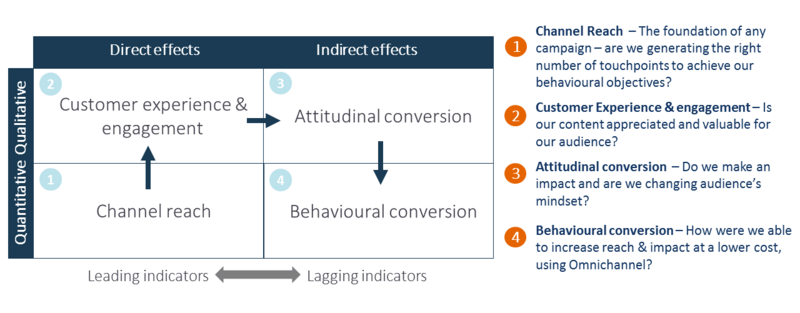One of the most valued learnings reported by participants who attend CELforPharma’s 2-day Strategic Omnichannel for Pharma Marketing is how to measure the ROI of their omnichannel campaigns.
Presented by Precision AQ (the new name of Across Health) experts Vladimir Rogiers and Olga Duvillard, the course draws inspiration from the FMCG industry to highlight the importance of using a holistic Key Performance Indicator (KPI) framework.
In this framework KPIs are categorised based on direct (leading) or indirect (lagging) effects, as well as whether they are quantitative or qualitative measures:

Reach (Leading / Quantitative):
Located in the lower left quadrant, KPIs in this category aim to answer the question, "Do we reach and connect with our audience?"
Metrics such as the number of unique visitors and/or impressions, click-through rate, and social media reach provide quantitative data on the campaign's ability to reach the intended audience.
Customer Experience & Engagement (Leading / Qualitative):
Moving to the upper left quadrant, the emphasis shifts to measuring engagement and customer experience. KPIs in this category provide insights into how well the content resonates with the target audience and whether it encourages active engagement.
The question to address here is, "Do they like our content and how we engage with them?" Metrics like comments, likes, shares, sentiment analysis, channel NPS (Net Promoter Score), and CES (Customer Effort Score) help assess the qualitative impact and level of engagement generated by the campaign.
Attitudinal Conversion (Lagging / Qualitative):
Shifting to the upper right quadrant, measuring attitudinal conversion focuses on assessing the potential impact of the campaign. KPIs in this category require analysing qualitative data related to brand perception and customer attitude. This category answers the question, "Will it make a difference?" Feedback, surveys, customer testimonials, and focus groups can provide valuable insights into how the campaign influenced customers' decisions and their willingness to take action.
Effectiveness (Lagging / Quantitative):
Finally, the lower right quadrant evaluates the overall effectiveness of the campaign. This quadrant seeks to answer the question, "How much of a difference did it make?" Quantitative measures play a vital role in assessing campaign effectiveness, including metrics such as sales revenue, market share, customer acquisition, customer retention, and return on investment (ROI). These metrics provide concrete data on the campaign's impact and the value it generated.
Effectively measuring the ROI of marketing campaigns is crucial for pharmaceutical marketers to optimise their strategies and investments. By applying the quadrant framework and utilising relevant metrics, pharma marketeers can gain valuable insights into campaign performance across different channels and take corrective actions where needed.

